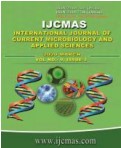


 National Academy of Agricultural Sciences (NAAS)
National Academy of Agricultural Sciences (NAAS)

|
PRINT ISSN : 2319-7692
Online ISSN : 2319-7706 Issues : 12 per year Publisher : Excellent Publishers Email : editorijcmas@gmail.com / submit@ijcmas.com Editor-in-chief: Dr.M.Prakash Index Copernicus ICV 2018: 95.39 NAAS RATING 2020: 5.38 |
Micronutrient malnutrition resulting from the dietary deficiency of important minerals such as Iron (Fe), Zinc (Zn), Copper (Cu) and Manganese (Mn) in the staple food crops like pearl millet leads to ubiquitous food-related health problems. In context to this present investigation was undertaken to study the phenotypic diversity among 48 maintainer (B) and restorer lines (R) of pearl millet genotypes for grain micronutrients concentration, yield and agro-morphological traits using multivariate approach. Higher range, large value of Shannon-weaver Diversity Index for both traits and genotypes and large differences in mean values for most of the characters showed that sufficient diversity existed among the genotypes and traits. Cluster analysis using unweighted pair group method of arithmetic averages (UPGMA) grouped the genotypes into five clusters with varied number which suggested the clear differentiation among B and R lines with some exceptions. Clustering of pearl millet genotypes from different geographical locations or source/origin into same cluster has confirmed that they are genetically related, and possibly from the same progenitor, but could have been separated by geographical or ecological barrier. The principal component analysis (PCA) revealed that most of the variation (68.83%) was accounted by first four PCA and genotypes from maintainer were clustered into left side of the biplot graph while the lines from the restorer category were distributed throughout the PCA biplot graph. Average Diversity Index of 1.883 and 3.792 for genotypes and traits respectively, further validated that the genotypes were more diverse among themselves and for all the traits studied. Association studies revealed significant positive correlation of grain Fe content with the grain Zn and Cu content; grain yield per plant with the plant height, panicle weight and dry fodder yield per plant; panicle weight with plant height, panicle length and dry fodder yield; panicle length with plant height and dry fodder yield per plant and dry fodder yield per plant with plant height. It indicated the likely effectiveness of simultaneous improvement of all these characters along with grain micronutrients in pearl millet. Grain yield per plant showed non-significant positive or negative correlation with grain micronutrients concentration thus suggesting improvement in nutrient content without compromising yield. The significant negative association between the grain yield and panicle weight with days to flowering has the great advantages in pearl millet cultivation as crop can fit into multiple cropping system in arid and semi-arid environments.
 |
 |
 |
 |
 |